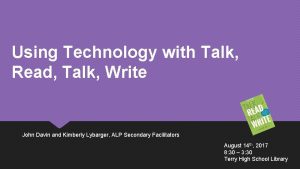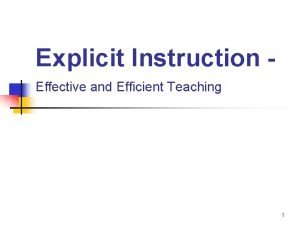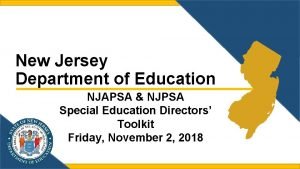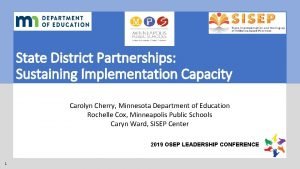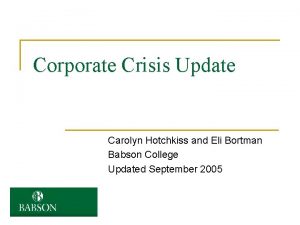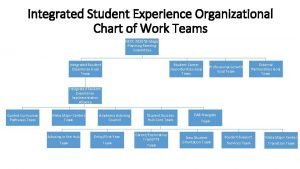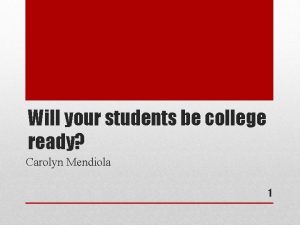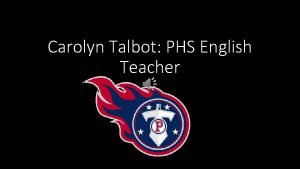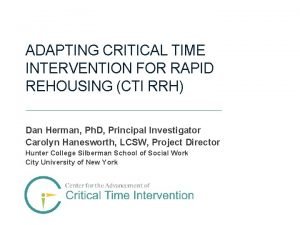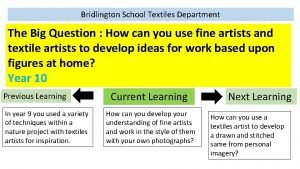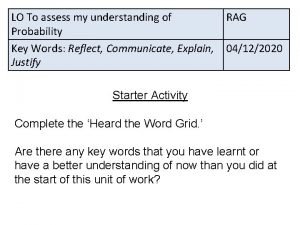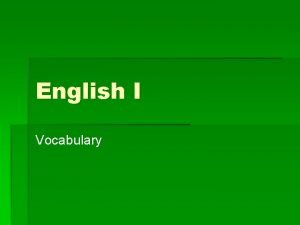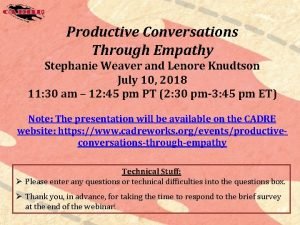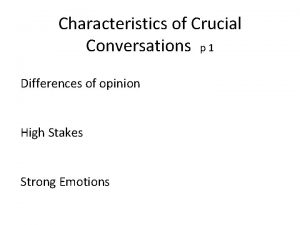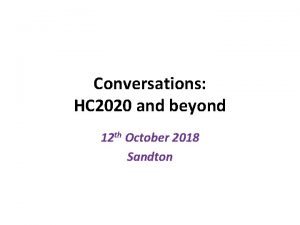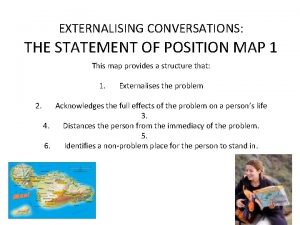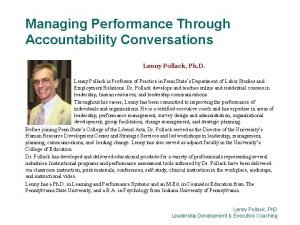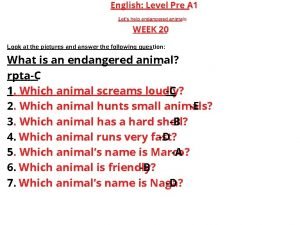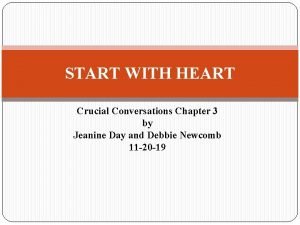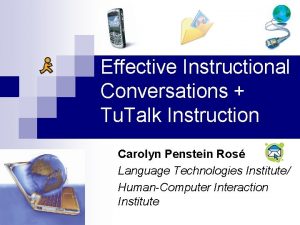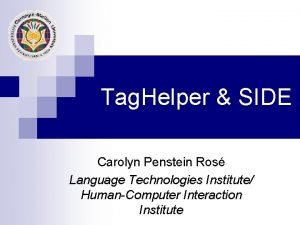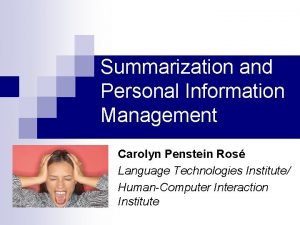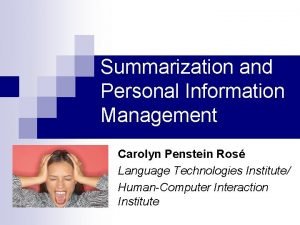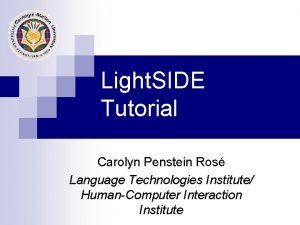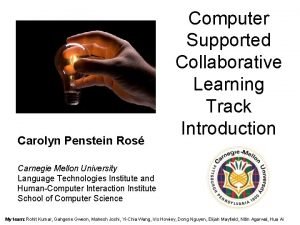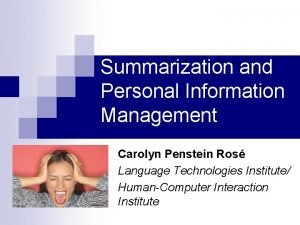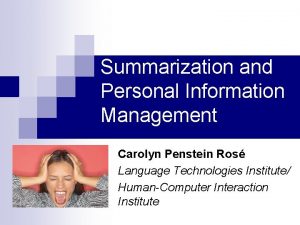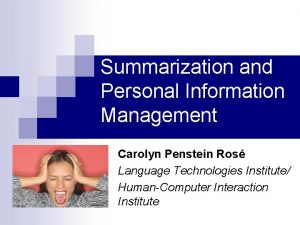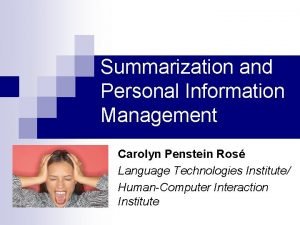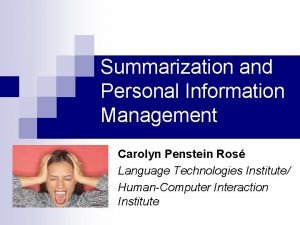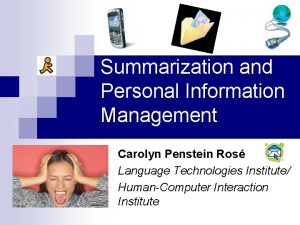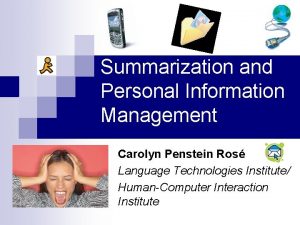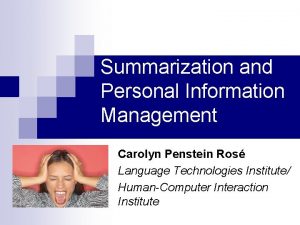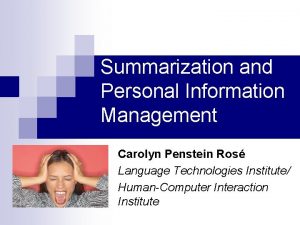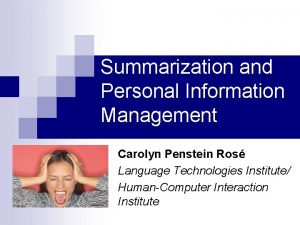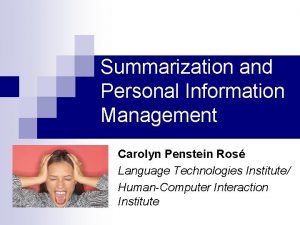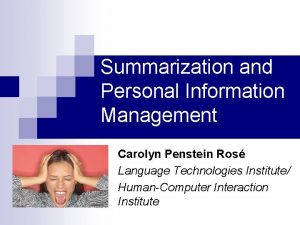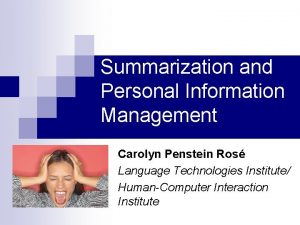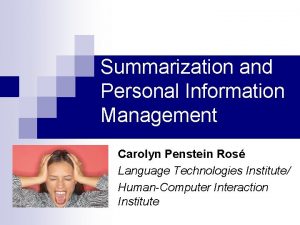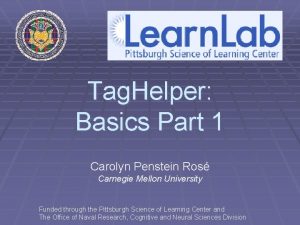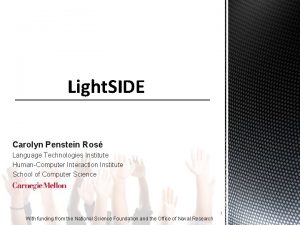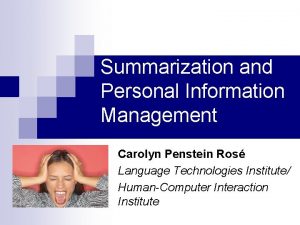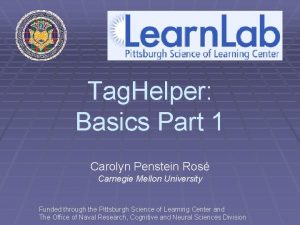Effective Instructional Conversations Tu Talk Instruction Carolyn Penstein




































- Slides: 36

Effective Instructional Conversations + Tu. Talk Instruction Carolyn Penstein Rosé Language Technologies Institute/ Human-Computer Interaction Institute

Design Principle Know what problem you are trying to solve!!

Design Process n What problem are you trying to solve? ¨ Formulate n analysis scheme When should you intervene? ¨ Use technologies like Tag. Helper and SIDE to track interaction and trigger support n What should the intervention be? ¨ Technologies support like Tu. Talk can be used to offer

What Makes Instructional Conversations Effective

Design Challenge: Collaborative Process Problems Hurt Learning Problems with the Process reduce learning Interaction Processes Cognitive Processes Learning

Collaboration support increases learning by changing Support structure is designed to elicit certain interaction processes, so Support Structure its success should be reflected in a difference in interaction processes Interaction Processes Cognitive Processes Learning

Collaboration support increases learning by changing But if the process difficulties are not interaction the same between X Support Structure student populations, then the support needs to be different too. Interaction Processes Cognitive Processes Learning

Goals of Scripted Collaboration “The basic goal of scripted cooperation is to increase achievement by having students perform cognitive activities that they might not otherwise do. In addition, scripted cooperation is expected to reduce the incidence of negative group processes because of the size of the cooperating unit and because of the explicit requirement to alternate roles. ”

Script Based Collaborative Learning Support n Static support approaches provide structure to offer support for collaboration before it begins n Script based support increases effective argumentation (Weinberger, 2003)

Social Script

What is a Knowledge Construction Dialogue?

Atlas: Knowledge Construction Dialogues n n Purpose: test “Ask, Don’t Tell” strategy in an ITS How can we get the most bang for our buck? ¨ How far can we go with finite state dialogue management? (Freedman, 2000) ¨ How far can we go with shallow concept grammars? (i. e. , Glass, 1999) n Knowledge Construction Dialogues (KCDs) ¨ Interactive directed lines of reasoning: analogies, concrete illustrations ¨ KCD Authoring Tool Suite (Jordan, Rosé, and Van. Lehn, 2001) n 55 KCDs fully implemented and pilot tested in 3 months

KCDs versus Minilessons versus Hints Here a few things to keep in mind when calculating acceleration for a body at rest. Acceleration is change in velocity over time. If velocity is not changing, then there is zero acceleration. Now, if for a finite time interval the velocity remains zero, then it is true that it is not changing. Therefore, when a body is at rest during a time interval, its acceleration within that time interval is zero. Tutor: Here a few things to keep in mind when calculating acceleration for a body at rest. Acceleration is change of what over time? Student: velocity Tutor: Right. If the velocity is not changing, what is the magnitude of the acceleration? Student: zero. Tutor: Good. If velocity remains zero within a time interval, how much is it changing? Student: zero Tutor: Super. So if a body is at rest during a time interval, what is the. . .

KCDs versus Minilessons versus What if this answer was wrong? Hints Here a few things to keep in mind when calculating acceleration for a body at rest. Acceleration is change in velocity over time. If velocity is not changing, then there is zero acceleration. Now, if for a finite time interval the velocity remains zero, then it is true that it is not changing. Therefore, when a body is at rest during a time interval, its acceleration within that time interval is zero. Tutor: Here a few things to keep in mind when calculating acceleration for a body at rest. Acceleration is change of what over time? Student: velocity Tutor: Right. If the velocity is not changing, what is the magnitude of the acceleration? Student: zero. Tutor: Good. If velocity remains zero within a time interval, how much is it changing? Student: zero Tutor: Super. So if a body is at rest during a time interval, what is the. . .

KCDs versus Minilessons versus Tutor: Right. If the velocity is not Hints changing, what is the magnitude of Here a few things to keep in mind when calculating acceleration for a body at rest. Acceleration is change in velocity over time. If velocity is not changing, then there is zero acceleration. Now, if for a finite time interval the velocity remains zero, then it is true that it is not changing. Therefore, when a body is at rest during a time interval, its acceleration within that time interval is zero. the acceleration? Student: I don’t know Tutor: Do you remember what acceleration means? Student: It’s change in velocity over time Tutor: Right. So then if velocity is not changing, what is acceleration? Student: Oh, zero. Tutor: OK. If velocity remains zero within a time interval, how much is it changing? …

Design Process Tips

Exploratory Learning Overview Worked Examples n n Problem Solving Goals Provided Negotiable Problem Solving Goals Only High Level Goals Given + hints Only High Level Goals Given + help requests Pure Exploratory Learning (Charnay & Reder, 1986) compare Worked Examples, Tutorials, Problem Solving, and Pure Exploration ¨ n Tutorial Learning Worked examples mixed with problem solving was the best (Touvinem & Sweller, 1999) Worked examples with problem solving beats Pure exploratory learning (Klahr & Nigam, to appear) tutorial learning plus problem solving is more efficient than pure exploratory learning

Exploratory Learning Overview Worked Examples n n Problem Solving Goals Provided Negotiable Problem Solving Goals Only High Level Goals Given + hints Only High Level Goals Given + help requests Pure Exploratory Learning Smithtown work (Shute & Glaser, 1990, etc. ) and Computer-Based Simulation Games (Leutner, 1993) involve only imposed high level goals ¨ n Tutorial Learning about a model or Survival (Leutner, 1993) demonstrates the importance of students actively requesting help Smithtown adapted to individual student needs

Exploratory Learning Overview Worked Examples n n Tutorial Learning Problem Solving Goals Provided Negotiable Problem Solving Goals Only High Level Goals Given + hints Only High Level Goals Given + help requests Pure Exploratory Learning The difference between problem solving and exploratory learning is the level at which goals are dictated Many state-of-the-art tutoring systems fall into the problem solving category where problem solving goals are dictated In an exploratory design environment, high level goals are dictated (improve efficiency), but problem solving goals (i. e. , add a reheat cycle) are negotiated Tutorial dialogue allows the tutor to influence problem solving goals (addressing cognitive load issues) while offering instruction and while allowing students to actively explore

Topic Analysis Reveals Important Patterns of Interaction Significant correlation between topic coverage and learning (R 2=. 715, N=21, p <. 05) General Conceptual Topics Analysis Specific Topics

Example Implemented Reflection Dialogue n n n n Tutor: Let’s stop for a minute and reflect on what we have seen. Having seen how changing T-Max (i. e. , the Maximum Temperature at the Heater Outlet) affects the efficiency of the cycle, do you think it is a good idea in general for the Maximum Temperature to be increased and kept high? Student: yes Tutor: Okay. Let’s think now about one important consequence of keeping T-Max high. What happens to the steam quality at the turbine exit if you increase the maximum temperature of the cycle? Student: Increases Tutor: Right. As increasing the temperature makes the efficiency and steam quality better, we should increase the maximum temperature of the cycle. But can we keep on increasing the maximum temperature at the heater outlet indefinitely, or are there limitations to keep in mind? Student: there are limitations such as material constraints Tutor: Great. we should try to keep T-Max (i. e. , the maximum temperature at the Heater outlet of the cycle) as high as possible without risking safety concerns or exceeding the maximum temperature the material can withstand. Keeping T-Max high increases efficiency and keeps the steam quality high, which are both important. This is an important principle to keep in mind while optimizing the efficiency of your cycle.

Tu. Talk Authoring Process

Scenario Goal 1 (Start Goal) Goal 1_Step 1 Goal 1_Step 2 Goal 1_Step 4 Goal 1_Step 3 Pair Scenario/ Script n Goal n Template n Step/Pair n Concept n Initiation Response 1 Response 2 Say 1 Say 2 Response 3 Sub Goal 1. 1

Getting Started Start by creating a new script n That script will contain all of the goals, templates, and concepts that you define n Could contain multiple ways of achieving the same goal (via alternative templates) n

Directed Lines of Reasoning n Building Blocks: Pairs are composed of an initiation and a response Tutor: Here a few things to keep in mind when calculating acceleration for a body at rest. Acceleration is change of what over time? Student: velocity Tutor: Right. If the velocity is not changing, what is the magnitude of the acceleration? Student: zero. Tutor: Good. If velocity remains zero within a time interval, how much is it changing? Student: zero Tutor: Super. So if a body is at rest during a time interval, what is the. . .

Building a Pair

Adding Phrases to Concepts

Elaborating a Template

Example Pair

Example Pair

Concept Manager

Scenario Goal 1 (Start Goal) Goal 1_Step 1 Goal 1_Step 2 Goal 1_Step 3 Pair Initiation Response 1 Response 2 Say 1 Say 2 Response 3 Sub Goal 1. 1 Goal 1_Step 4

Previewer

Test Interface

Some tips n Better to have several short turns than fewer long turns n Try to build the learner’s/user’s vocabulary (shaping) • It may help you avoid unanticipated responses n Try to think about what is it that we are trying to elicit from the student when writing tutor turns (initiations) n Author as many possible responses as you can in the time available ¨ Catch all makes the machine look dumb!

Questions?
 Amateurs discuss tactics professionals discuss logistics
Amateurs discuss tactics professionals discuss logistics The words use are not
The words use are not Talk read talk write
Talk read talk write Site:slidetodoc.com
Site:slidetodoc.com Differentiated instruction vs individualized instruction
Differentiated instruction vs individualized instruction Anita archer explicit instruction
Anita archer explicit instruction Carolyn washburn
Carolyn washburn Njapsa
Njapsa How to tell wild animals poem
How to tell wild animals poem Carolyn ells
Carolyn ells Carolyn shread
Carolyn shread Carolyn cherry
Carolyn cherry Carolyn brownawell
Carolyn brownawell Carolyn sourek
Carolyn sourek Carolyn hotchkiss
Carolyn hotchkiss Carolyn graham jazz chants
Carolyn graham jazz chants Carolyn knoepfler
Carolyn knoepfler Caroline mendiola
Caroline mendiola Carolyn maull
Carolyn maull Carolyn talbot
Carolyn talbot Carolyn laorno
Carolyn laorno Stury
Stury Carolyn hanesworth
Carolyn hanesworth Carolyn saxby facts
Carolyn saxby facts Carolyn boroden
Carolyn boroden Clive wants to estimate the number of bees in a beehive
Clive wants to estimate the number of bees in a beehive Carolyn johnston md
Carolyn johnston md The old lane estate was a
The old lane estate was a Stephanie weaver md
Stephanie weaver md Characteristics of a conversation
Characteristics of a conversation Fierce conversations 7 principles
Fierce conversations 7 principles Statement of position map 1
Statement of position map 1 Accountable conversations
Accountable conversations Let's help endangered animals
Let's help endangered animals Start with heart crucial conversations
Start with heart crucial conversations Antiracist teaching
Antiracist teaching Types of difficult conversations
Types of difficult conversations


